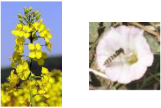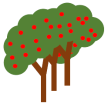- Index
- >Innovation
- >The innovation box
- >8. Biocontrol strategies.
- >Research results
Contents
- Biocontrol products: definitions and work in progress
- Auxilary macro-organisms
- Chemical mediators
- Natural substances
- Living microorganisms
- Focus on PRIs
- Biocontrol through plant diversity
Biocontrol products: definitions and work in progress
Auxilary macro-organismes
Invertebrates, insects, mites or nematodes. Modes of action: parasitoids, predators or entomopathogenic nematodes.
The EGI (Ecology and Genetics of Insests) team of IGEPP

Auxilary macro-organismes, in collaboration with LARIS, Plante&Cité, FREDON PACA, KOPPERT and IF TECH, has developed an integrated biological protection strategy with the use of a nematode and an auxiliary insect, which has led to commercial products (Tigranem,Tigrador). A tool also been created to quantify leaf discolouration and evaluate the effectiveness of biocontrol products - PETAAL projet - (2009 - 2012) – FUI funds.

Bruno Jaloux
Bruno Jaloux
bruno.jaloux @ agrocampus-ouest.fr
Chemical mediators
Insect pheromones and kairomones. Modes of action: sexual confusion, mass entrapment.

Chemical mediators
The EGI team of IGEPP has shown that low doses of neonicotinoids promote the reproduction of pests by stimulating their sense of smell -
PHEROTOX projet
(2012-2016) - ANR funds
The potential interactions between low doses of insectmust be taken into account when using them for biocontrol.

Sylvia Anton
Natural substances
Substances of plant, animal, microbial and mineral origin. Modes of action: direct effect on the pest or stimulation of the defenses of the plant.

Natural substancesDuring her PhD thesis at LBPV, Sabine Tourneur evaluates the role of miPEPs (new class of regulatory peptides) in controlling the interaction between sunflower and the parasitic plant orobanche - miPEPITO project (2017-2020) in collaboration with
MicroPEP Technologies
- ANR funds.
![]()
Philippe Delavault
Philippe Delavaut
philippe.delavault @ unv-nantes.fr
 IRHS
is studying the ability of secondary metabolites extracted from microorganisms to induce plant defenses (qPFD® test) or inhibit the growth of phytopathogenic fungi - NABUCO Projet (2015-2018) in collaboration with
Agrauxine - Lesaffre Plant Care
- Ministry of Agriculture funds.
IRHS
is studying the ability of secondary metabolites extracted from microorganisms to induce plant defenses (qPFD® test) or inhibit the growth of phytopathogenic fungi - NABUCO Projet (2015-2018) in collaboration with
Agrauxine - Lesaffre Plant Care
- Ministry of Agriculture funds.

Thomas Guillemette
Thomas Guillemette
thomas.guillemette @ univ-angers.fr
 IRHS and SONAS have patented natural substances capable of marking pests more ensitive to plant defenses.
IRHS and SONAS have patented natural substances capable of marking pests more ensitive to plant defenses.
These "sensitines" could act in synergy with PRIs (Plant Resistance Inducers).
Living microorganisms
Fungi, bacteria, viruses. Modes of action: direct effect o the pest, nutritional or spatial competition, stimulation of the defenses of the plant.
![]()
Living microorganismsIRHS
identifies microorganisms that are aggressive to phytopathogenic fungi -NABUCO project (2015-2018) in collaboration with
Agrauxine - Lesaffre Plant Care
- Ministry of Agriculture funds.

Thomas Guillemette
Thomas Guillemette
thomas.guillemette @ univ-angers.fr

Living microorganismsSamir Rezki's thesis (2014-2017) at
IRHS
studied the behaviour of microbiota associated with seeds during the transmission of phytopathogenic agents -
MetaSEED project
(2014-2016) in collaboration with
HM Clause
and
Vilmorin
– funded by Région Pays de la Loire
Microbial populations could thus be identified as potential biocontrol agents capable of competing with plant pathogens transmitted by/to seeds.

Mathieu Barret
Matthieu Barret
FOCUS on PRIs
Plant Resistance Inducers (PRIS): any no-pathogenc micro organism cabalbe of promoting resistance in plants to biotic stress. http://elicitra.org/

PRIs
IRHS and UEH are working on the integration of PRIs in the management of apple orchards under production conditions ( PEPS project - 2014-2018 – Casdar funds and Tavinnov projet -2017-2020- SMaCH INRA meta-programme funds): are particularly studied factors influencing the effectiveness of PRIs (environment, inputs, others), the sustainability of this protection strategy.

Marie-Noelle Brisset
Marie-Noelle Brisset
marie-noelle.brisset @ inra.fr
Romain Warneys' PhD thesis, carried out at IRHS as part of the Pomme d'épi project (2016-2019 - funded by RFI Objectif Végétal ) and Michaela Skopikova's PhD thesis at SONAS (2017-2020), aim to explore the mode of action of PRIs at different levels (epignetic, transcriptomoc, protein and metabolic) in apple trees.

Alexandre Degrave
Alexandre Degrave
alexendre.degrave@agrocampus-ouest.fr

PRIs
The effectiveness of PRIs depends on the physiological state of the plant, which is partly conditioned by abiotic stress IRHS is developing tools for evaluating this physiological state,
based on expression of stress marker genes and imaging techniques (ESTIM project: joint laboratory with SAS Arexhor Pays de la Loire - ANR LabCom funds) and activation of transposable elements.

Mathieu Gaucher
Mathieu Gaucher
IRHS seeks to combine constituent defenses, QTLs partial genetic resistance and PRIs to control apple scab. This is the subject of Juliette bénéjam's PhD thesis (2017-2020), associated with the PREDIRE project (2016-2019 - funded by RFI Objectif Végétal ) and QTLstim Project (2017-2020 – INRA funds).

Charles-Eric Durel
Charles-Eric Durel

PRIs
Among the defense genes induced by PRIs, some are involved in the production of volatile organic compounds. IRHS and EGI team of IEPP are studying PRI's ability to modify the behaviour of the aphid by olfactometry and ElectroPenetroGraphy.

Sylvia Anton
Sylvia Anton
Biocontrol through plant diversity

Biocontrol
Agricultural pratices, the flora of the field and its border, agricultural landscape are major determinants of biological control. A conceptual model integrating
them is being developed at EGI team of
IGEPP
- PEERLESS project (2013-2017) – funded by ANR Agrobiosphère and Chaire AEI
. Anna Pollier's thesis improved flower strips for the biological control of insect pests of rapeseed and wheat.

Yann Tricault
Yann Tricault
yann.tricault@agrocampus-ouest.fr

Biocontrol
Nicolas Carton's PhD thesis at LEVA made it possible to propose combinations of lupine and cereals to control weeks while ensuring the productivity of both crops.

Guenaëlle Hellou
Guenaëlle Hellou

Biocontrol
Associated crops can also provide food resources for auxiliaires; Martin Luquet's PhD thesis at EGI team of IGEPP (2016-2019) focuses on parasitoids of aphids in cereal-protein associations.

Bruno Jaloux
Bruno Jaloux
bruno.jaloux @ agrocampus-ouest.fr

LBPV seeks to indentify legume species with negatives allelopathic activitity in relation to the rowing orobanch, with a view to associating them with rapessed crops - PHERAFAB projet (2014-2017) - CASDAR funds

Philippe Simier
Philippe Simier
philippe.simier @ univ-nantes.fr

Biocontrol
Mixing varieties or species of different resistances helps to limit the spread of pets and slow down resistance circumvention. A mathematical model has been developed at the IRHS to design these mixtures according to the constraints of the plot, and successfully used in the projets Vergers cidricoles de demain (2012-2014 then 2015-2018) - CASDAR funds.
Model usable on all crops, at plot, farm or landscape scale.

Nathalia Sapoukhina
Nathalia Sapoukhina
Contact
Looking for partners?
Two contacts to support your projects:
- Emeline Defossez,
![]() contact to support your R&D projects and put you in touch
contact to support your R&D projects and put you in touch
- Tanegmart Redjala
![]() Close interface with the laboratoires of the Federative Research Structure "Quasav"
Close interface with the laboratoires of the Federative Research Structure "Quasav"


